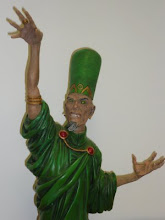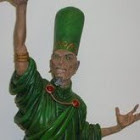
Piping hot science fiction delivered with outstanding art, this volume is the first two chapters of The Beast Trilogy and a really compelling comic. Nike Hatzfeld is a man who can remember all of his life down to the first days after his birth. He was an orphan in war torn Sarajevo, in a damaged hospital with two other children Amir and Leyla and Nike is looking for them. He lives in a world where memory and knowledge are under violent ass ult from the Obscurantis Order who are determined to reshape the world, Nike's memory is a valuable prize for them. Leyla is a astrophysicist who is involved in investigation a stream of messages from space, Amir is a bodyguard about to start a new contract. The story is dramatic and far reaching, the reveals are superbly staged and the cast very engaging.
Enki Bilal carries of the mix of big ideas and a believable cast and context with flair and energy. The context is a future that has been battered a great deal by some series of conflicts, information is provided as the cast require it not the reader. This is neither frustrating nor confusing as the clarity and momentum of the story is so strong. The plot reveals itself steadily, nicely growing in depth and force as the unexpected twists and turns are revealed. Nike, Leyla and Amir emerge as very forceful characters, linked in subtle and sharp ways. Doctor Warhole is a superb creation, an evil genius with plans for global domination, he provides the controlled menace that drives the story.
The art is simply astounding, it has a dark and almost unfinished look to it as though Enki Bilal drew with chalk and brushed his sleeve lightly over the pages. It gives the physical context of the story a slightly unreal quality, it feels like science fiction art. The technology does not shine, it is all in use and showing it, the grit of the plot is matched by the grit of the art.
The very best thing about this story is that it could only be told properly as a comic, the interplay between story and art, the limitless budget of comics and the frozen timeline of sequential panels do more than frame the story, they allow it to be told. This story exploits the possibilities of comics in a genuinely exciting way, a star burst of controlled creativity, astonishing.









